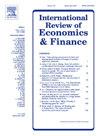Digital economy and high-quality agricultural development
IF 4.8
2区 经济学
Q1 BUSINESS, FINANCE
引用次数: 0
Abstract
Despite the growing recognition of digital transformation in agriculture, scholarly understanding remains fragmented regarding the precise mechanisms through which digital technologies contribute to high-quality agricultural development. Prior research predominantly examines isolated digital applications or technological diffusion patterns while neglecting comprehensive analytical frameworks that integrate multidimensional impacts across diverse agricultural contexts. This knowledge gap hampers evidence-based policymaking for agricultural modernization in the digital era, particularly within heterogeneous development landscapes. Herein, we examine the relationship between digital economy and high-quality agricultural development utilizing provincial panel data from China (2010–2022), constructing a sophisticated evaluation system incorporating 21 indicators across five dimensions: innovation capacity, coordination efficiency, environmental sustainability, external openness, and shared prosperity. Our methodological approach combines fixed-effects models with instrumental variables, propensity score matching, and Heckman selection techniques to establish robust causal relationships, revealing three distinct transmission pathways: agricultural technology innovation enhances technological capabilities, human capital development facilitates knowledge accumulation, and industrial structure optimization promotes sectoral advancement. Our heterogeneity analysis demonstrates asymmetric patterns wherein digital economy exerts more profound influence in Central-Western regions compared to Eastern provinces, while economically advanced areas derive greater agricultural benefits from digital transformation than less developed regions. These findings advance the theoretical discourse on agricultural modernization by illuminating context-dependent digital transformation effects and provide nuanced policy guidance emphasizing differentiated regional strategies, targeted capacity-building initiatives, and integrated policy frameworks that accommodate China's diverse economic landscape.
求助全文
约1分钟内获得全文
求助全文
来源期刊
CiteScore
7.30
自引率
2.20%
发文量
253
期刊介绍:
The International Review of Economics & Finance (IREF) is a scholarly journal devoted to the publication of high quality theoretical and empirical articles in all areas of international economics, macroeconomics and financial economics. Contributions that facilitate the communications between the real and the financial sectors of the economy are of particular interest.

 求助内容:
求助内容: 应助结果提醒方式:
应助结果提醒方式:


